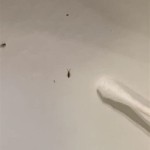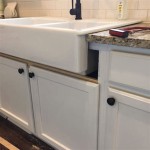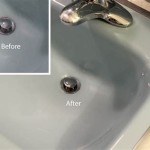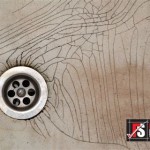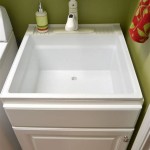Why Does My Kitchen Sink Smell? Understanding and Addressing Kitchen Sink Odors
A persistent foul odor emanating from a kitchen sink drain can be a significant nuisance and a sign of underlying issues. Identifying the source and understanding the causes are the first steps in effectively addressing the problem. This article will explore common culprits, explain the mechanisms behind the smells, and provide strategies for mitigating and preventing future occurrences.
Kitchen sinks are susceptible to a variety of odor-causing conditions due to the constant flow of food particles, grease, and other organic matter down the drain. Over time, this debris can accumulate and decompose, creating unpleasant smells that permeate the kitchen. Ignoring these odors can lead to unsanitary conditions and potentially attract pests.
Biofilm Buildup and Bacterial Activity
The most common reason for a smelly kitchen sink is the formation of biofilm within the drainpipe. Biofilm is a slimy, sticky layer of microorganisms that thrives in moist environments with a readily available food source. In a kitchen sink drain, this food source is the organic waste that gets washed down the drain daily. Food scraps, fats, oils, and grease (FOG) all contribute to the biofilm's growth.
As the organic material decomposes, bacteria within the biofilm break it down. This decomposition process releases various gases, including hydrogen sulfide, methane, and ammonia. Hydrogen sulfide is a particularly potent gas, known for its characteristic rotten egg smell. The combination of these gases creates the unpleasant odor that rises up from the sink drain.
The warm, dark, and moist environment inside the drainpipe provides ideal conditions for bacterial growth. The P-trap, a curved pipe located under the sink, is particularly vulnerable to biofilm buildup. The P-trap is designed to hold water, which acts as a barrier to prevent sewer gases from escaping into the house. However, this standing water also creates a breeding ground for bacteria if food particles accumulate in the trap.
Furthermore, the type of food waste disposed of down the drain can influence the specific gases produced and the intensity of the odor. Foods high in sulfur, such as eggs, onions, and cruciferous vegetables (broccoli, cauliflower, cabbage), tend to produce more hydrogen sulfide. Grease and oil, when solidified in the pipes, create a sticky matrix that traps even more organic matter, further exacerbating the problem.
Clogged or Partially Blocked Drain
A clogged or partially blocked drain can also contribute to a smelly kitchen sink. Even a small obstruction can restrict the flow of water, allowing food particles to accumulate and decompose. This stagnant water creates a breeding ground for bacteria and amplifies the production of foul-smelling gases.
Clogs can be caused by a variety of factors, including excessive amounts of food scraps, grease, hair, and even small objects that accidentally fall down the drain. Over time, these materials can combine and solidify, forming a stubborn blockage that restricts water flow.
When the drain is partially blocked, water may drain slowly, leaving behind a residue of food particles. This residue provides a constant source of nutrients for bacteria, leading to increased biofilm formation and odor production. In severe cases, a complete blockage can cause water to back up into the sink, creating a highly unsanitary and odorous environment.
The P-trap is particularly susceptible to clogs because its curved shape can trap debris. Large food particles, such as fruit pits or bones, can easily get lodged in the P-trap, creating a nucleus for further buildup. Grease and oil, when cooled, solidify and cling to the pipe walls, gradually narrowing the drainpipe and restricting water flow.
Beyond the immediate odor issue, a clogged drain can also put strain on the plumbing system. Backed-up water can create pressure on the pipes, potentially leading to leaks or even burst pipes in severe cases. Therefore, addressing a clogged drain promptly is crucial for both odor control and plumbing maintenance.
Issues with the Garbage Disposal
A garbage disposal can be a convenient appliance, but it can also be a significant contributor to kitchen sink odors if not properly maintained. The garbage disposal grinds food waste into smaller pieces, allowing it to be flushed down the drain. However, if food particles remain trapped within the disposal unit, they can decompose and produce unpleasant smells.
Over time, food particles can become lodged in the grinding chamber, around the blades, and in the splash guard. These trapped particles provide a breeding ground for bacteria, leading to the production of foul-smelling gases. The garbage disposal's moist environment further promotes bacterial growth.
Furthermore, not all types of food waste are suitable for disposal. Fibrous foods, such as celery stalks, corn husks, and banana peels, can get tangled in the disposal's blades, causing jams and blockages. Grease and oil should never be poured down a garbage disposal, as they can solidify and clog the drainpipe.
Improper use of the garbage disposal can also contribute to odor problems. Overfilling the disposal can overload the motor and prevent the unit from grinding food waste properly. Running the disposal with insufficient water can also lead to food particles becoming stuck in the grinding chamber.
In addition to food waste, other materials, such as coffee grounds, can contribute to odor problems. Coffee grounds can accumulate in the drainpipe and form a dense sludge that restricts water flow and promotes bacterial growth. Citrus peels, while often recommended for freshening the disposal, can sometimes exacerbate odor problems if they are not properly processed and flushed down the drain.
Sewer Gas Leakage
While less common, sewer gas leakage is a serious potential cause of a foul odor emanating from a kitchen sink. Sewer gas contains a variety of potentially harmful gases, including methane, hydrogen sulfide, and ammonia. Exposure to high concentrations of sewer gas can cause health problems, such as headaches, nausea, dizziness, and respiratory irritation.
The P-trap under the sink is designed to prevent sewer gases from entering the house. However, if the P-trap dries out, loses its seal, or is improperly installed, sewer gases can escape into the kitchen. This can occur if the sink is not used for an extended period of time, allowing the water in the P-trap to evaporate.
Another potential cause of sewer gas leakage is a damaged or improperly vented drainpipe. Drainpipes are typically vented to the outside air to allow for proper airflow and to prevent pressure buildup in the plumbing system. If the vent is blocked or damaged, it can create negative pressure in the drainpipe, drawing sewer gases into the house.
Cracks or leaks in the drainpipe can also allow sewer gases to escape. These cracks can be caused by corrosion, damage from tree roots, or improper installation. A faulty connection between the drainpipe and the sink can also create a pathway for sewer gases to enter the kitchen.
Identifying sewer gas leakage can be challenging. The odor is often described as a rotten egg smell, but it can sometimes be mistaken for other sources of kitchen odors. If the odor is persistent, strong, and accompanied by symptoms such as headaches or nausea, it is important to contact a qualified plumber to inspect the plumbing system for potential leaks.
Infrequent Use and Drain Dry-Out
Infrequent use of a kitchen sink can also contribute to odor problems. When a sink is not used regularly, the water in the P-trap can evaporate, breaking the seal that prevents sewer gases from entering the house. This is particularly common in vacation homes or sinks that are rarely used.
As the water evaporates, the P-trap becomes ineffective, allowing sewer gases to flow freely into the kitchen. The odor may be intermittent, appearing only when the sink has not been used for a period of time. Running water down the drain can temporarily resolve the problem by refilling the P-trap, but the odor will return if the sink is not used regularly.
In addition to breaking the sewer gas seal, infrequent use can also lead to biofilm buildup. When water is not flowing through the drainpipe regularly, food particles and other organic matter can accumulate and stagnate. This stagnant water provides an ideal environment for bacterial growth and odor production.
To prevent odors caused by infrequent use, it is important to periodically run water down the drain. This will help to keep the P-trap filled and flush out any accumulated debris. Adding a small amount of mineral oil to the P-trap can also help to slow down evaporation and maintain the seal longer.
Furthermore, ensuring proper ventilation around the sink can help to prevent moisture buildup and reduce the risk of biofilm formation. Opening windows or using a ventilation fan can help to circulate air and keep the area dry.

Why Does My Kitchen Sink Smell Like Sewer Mike Diamond

5 Reasons Why Your Kitchen Sink Smells And How To Get Rid Of It Absolute Plumbing Electrical Heating Air
:max_bytes(150000):strip_icc()/kitchen-smells-c8c99aa82ac7481b860c3b0a8feb1a32.jpg?strip=all)
5 Common Kitchen Smell Sources

Why Does My Drain Smell Bad Any Hour Services Utah

Deodorize A Kitchen Sink That Smells 5 Ways Youtube

Stinky Sink Here S What Causes A Foul Drain Smell

How To Remove Musty Odors From Kitchen Sink Water Damage

Why Does My Kitchen Sink Smell And How To Fix The Brisbane Plumbers

How To Fix Smelly Sink Drains Using At Home Blockbusters

Why Does My Sink Smell Service Pros Plumbing
